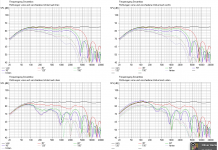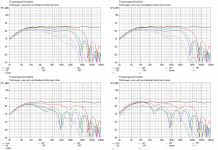I would go for LR4. It is only a switch in miniDSP. This way less bass is leaking out of the modal region into the transition region.
How would having the woofer serve only the modal region be an advantage? As far as I understand, modal, transitional or statistical behaviour is a function of room and frequency, so the (nature and effect of the) behaviour in a certan frequency range should be independant of which driver is producing the sound…
After further studying the TMT responses and doing some math, it seems to me that the vertical directivity I'm gaining by this arrangement doesn't suffice to reduce floor bounce at the intended LP, although it may well attenuate other detrimental reflections, e.g. from the ceiling. Is there any published research on the audibility and effect on perceived sound quality of the floor bounce, apart from Bech's papers?
After further studying the TMT responses and doing some math, it seems to me that the vertical directivity I'm gaining by this arrangement doesn't suffice to reduce floor bounce at the intended LP, although it may well attenuate other detrimental reflections, e.g. from the ceiling. Is there any published research on the audibility and effect on perceived sound quality of the floor bounce, apart from Bech's papers?
Above the schroeder F, boundary effects come into play that do not exists in the modal region. As a result, the driver's relative position to surfaces start to play a role. The woofer would then start radiation into half space. On the floor that might not be an issue but the ceiling is further away and you might get a bounce from there, especially if crossed high with a flat filter, because the woofer is still omnipolar.
It is a purely theoretical consideration but a safe bet so to speak.
But since you can change miniDSP on the spot you might give it a try if you plan to perform measurements at the listening position.
Also, check 6.2.1 in Toole. After all, floor and ceiling bounces are not that
big of a deal especially if there is carpet on the floor.
In my design I take advantage of the real D'Appo because I can and I have a pretty reflective floor. The sound will show if that design measure is required for my place.
It is a purely theoretical consideration but a safe bet so to speak.
But since you can change miniDSP on the spot you might give it a try if you plan to perform measurements at the listening position.
Also, check 6.2.1 in Toole. After all, floor and ceiling bounces are not that
big of a deal especially if there is carpet on the floor.
In my design I take advantage of the real D'Appo because I can and I have a pretty reflective floor. The sound will show if that design measure is required for my place.
Last edited:
As to the first point: If I understand you correctly, you are aiming at reducing the ceiling bounce by avoiding radiation from further away resp. down (i.e. from the woofer). But in my listing situation (3 m ceiling height, 3.1 m listening distance) the frequencies of the first ceiling bounce nulls will always be within the modal region of the room, regardless of W-M crossover point or alignment, and the first nulls above the transition region will always be caused by the midrange driver. So I guess the lower XO and/or steeper filter wouldn't help much there.
As to the second: Thanks for pointing me to the discussion in Toole! After rereading it, I'm asking myself if we aren't discussing two different but related phenomena:
On the one hand, there are first-order reflections, not qualified by reference to a certain frequency; this seems to be what Bech and Toole (and Toole and Olive) are discussing. These are easily treated with carpets et al. because they are mainly detrimental in the frequency range above 2 kHz.
On the other hand, when talking about (first) floor bounce nulls, we're looking at destructive interferences at the listening position that only occur at specific frequencies. Since the interferences result in clearly visible FR anomalies for the early sound, their influence on timbre should be equally clearly identifiable, I think (at least if you don't take into account psycho-acoustic arguments à la Linkwitz). At the same time, they occur at frequencies where absorption isn't particularly effective.
At least that's my reasoning behind trying to avoid the nulls in the first place – but maybe I'm going wrong somewhere?
As to the second: Thanks for pointing me to the discussion in Toole! After rereading it, I'm asking myself if we aren't discussing two different but related phenomena:
On the one hand, there are first-order reflections, not qualified by reference to a certain frequency; this seems to be what Bech and Toole (and Toole and Olive) are discussing. These are easily treated with carpets et al. because they are mainly detrimental in the frequency range above 2 kHz.
On the other hand, when talking about (first) floor bounce nulls, we're looking at destructive interferences at the listening position that only occur at specific frequencies. Since the interferences result in clearly visible FR anomalies for the early sound, their influence on timbre should be equally clearly identifiable, I think (at least if you don't take into account psycho-acoustic arguments à la Linkwitz). At the same time, they occur at frequencies where absorption isn't particularly effective.
At least that's my reasoning behind trying to avoid the nulls in the first place – but maybe I'm going wrong somewhere?
Sorry, I did not want to confuse you with a theoretical consideration of high cross-over F and flat filters.As to the first point: If I understand you correctly, you are aiming at reducing the ceiling bounce by avoiding radiation from further away resp. down (i.e. from the woofer).
And so they become a don't care.But in my listing situation (3 m ceiling height, 3.1 m listening distance) the frequencies of the first ceiling bounce nulls will always be within the modal region of the room, regardless of W-M crossover point or alignment,
Correct. Again the theoretical point of view. On the other hand, as mentioned, LR2 vs. 4 is switch in miniDSP. And perosnally I would set it to LR4.and the first nulls above the transition region will always be caused by the midrange driver. So I guess the lower XO and/or steeper filter wouldn't help much there.
They are all related. It is just a matter of F or wave length what the results are.As to the second: Thanks for pointing me to the discussion in Toole! After rereading it, I'm asking myself if we aren't discussing two different but related phenomena:
I guess we agree now that these have to occur above the modal region and the earliest within the transition zone, right ? So we are talking in the low hundrets of Hz but above say 200 Hz.On the other hand, when talking about (first) floor bounce nulls, we're looking at destructive interferences at the listening position that only occur at specific frequencies. Since the interferences result in clearly visible FR anomalies for the early sound, their influence on timbre should be equally clearly identifiable, I think (at least if you don't take into account psycho-acoustic arguments à la Linkwitz). At the same time, they occur at frequencies where absorption isn't particularly effective.
My peronal experience with these interferences is that I do not notice them or at least don't perceive them as disturbing.
You're absolutely right about LR4 – while maybe for different reasons, it's my default option, too. But it was interesting to see how the (simulated) drivers I chose are performing with a flatter filter.
And yes, the frequency range I'm concerned with in the handling of floor reflections is basically above the modal region and below where "room friendly" absorption becomes feasible, which means the low and middle hundreds of Hz. I guess some experiments with different configurations are in order for me before deciding on the importance of the bounces as a design constraint for me…
And yes, the frequency range I'm concerned with in the handling of floor reflections is basically above the modal region and below where "room friendly" absorption becomes feasible, which means the low and middle hundreds of Hz. I guess some experiments with different configurations are in order for me before deciding on the importance of the bounces as a design constraint for me…
Unfortunately, I have no scientific reference on hand that deals with the described interferences. Otherwise I would have pointed you to them, of course.
- Status
- Not open for further replies.
- Home
- Loudspeakers
- Multi-Way
- Sanity check on my Endeavour project

